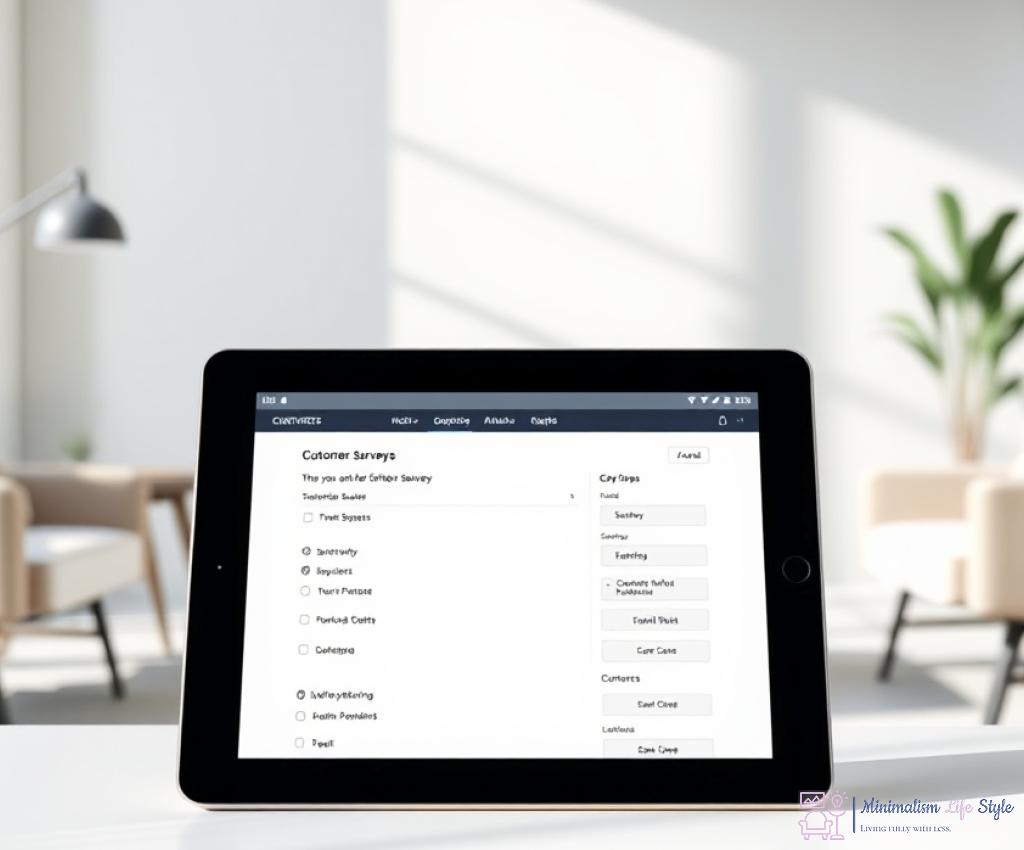Streamlined Surveys: Asking the Right Questions

In the fast-paced world of customer feedback, the key to unlocking valuable insights lies in the questions we ask. Gone are the days of overwhelming surveys filled with endless queries. Instead, the focus should be on crafting streamlined surveys that cut through the noise and get to the heart of customer sentiments. But how do we achieve this minimalism without sacrificing depth?
When designing a survey, it’s vital to hone in on what truly matters to your customers. Effective questions not only gather essential data but also encourage participation. Here are some strategies to consider when crafting your questions:
- Be Specific: Instead of asking vague questions, target specific aspects of the customer experience.
- Utilize Scales: Incorporate rating scales to quantify responses, making it easier to analyze data.
- Open-Ended vs. Closed-Ended: Balance your questions between open-ended for qualitative insights and closed-ended for quantitative data.
- Avoid Jargon: Use clear and simple language that resonates with your audience.
By focusing on clarity and relevance, your surveys will not only yield more accurate insights but will also enhance customer engagement.
Once you’ve gathered feedback, the next step is to analyze the responses efficiently. Rather than sifting through mountains of data, consider using a structured approach. Below is a simple table that outlines the most effective ways to evaluate customer feedback:
| Evaluation Method | Description |
|---|---|
| Trend Analysis | Look for patterns over time to identify recurring themes in customer feedback. |
| Sentiment Analysis | Utilize tools to gauge customer emotions behind their responses. |
| Actionable Insights | Transform qualitative feedback into specific actions for improvement. |
By utilizing these methods, businesses can quickly identify key areas for improvement, ensuring that customer feedback leads to meaningful changes.
The Power of Qualitative Feedback: Listening Deeply
In the realm of customer feedback, understanding the nuances of qualitative insights can significantly enhance the decision-making process. While quantitative data provides a broad overview of customer sentiments, qualitative feedback dives deeper, allowing businesses to truly grasp the feelings and motivations of their customers. This depth of understanding is crucial for fostering genuine connections and driving impactful changes.
Qualitative feedback offers a rich tapestry of information that numbers alone cannot convey. By actively listening to customers and valuing their in-depth responses, companies can uncover hidden gems of wisdom that might otherwise go unnoticed. Here are some powerful techniques to harness the strength of qualitative insights:
- Conduct Interactive Sessions: Use focus groups or one-on-one interviews to engage customers in meaningful dialogue. This allows for deeper exploration of their experiences.
- Create Open-Ended Questions: Encourage customers to share their thoughts freely. This can lead to unexpected insights that structured surveys might miss.
- Utilize Social Listening: Monitor social media platforms to capture authentic customer voices and sentiments in real-time.
Gathering qualitative feedback is only the beginning; the real challenge lies in transforming these insights into actionable strategies. Businesses must take deliberate steps to ensure that this feedback translates into real-world improvements. Here are effective approaches to consider:
- Prioritize Themes: After collecting qualitative data, categorize the feedback into themes that resonate most with your customer base.
- Engage Cross-Functional Teams: Involve different departments in discussions around qualitative insights to foster a holistic approach to customer feedback.
- Implement Changes and Communicate: Once feedback has been analyzed and prioritized, implement necessary changes and communicate these to your customers to show that their voices matter.
In conclusion, qualitative feedback is a powerful tool that, when leveraged correctly, can provide invaluable insights. By listening deeply and responding thoughtfully, businesses can cultivate stronger relationships with their customers and drive meaningful change.
Automating Insights: Tools for Efficient Analysis
In an era where data is abundant yet attention spans are fleeting, the ability to streamline customer feedback analysis is crucial. Automation offers a potent solution, enabling businesses to sift through vast amounts of information swiftly and effectively. This not only improves efficiency but also ensures that essential insights are not lost in the noise. Embracing technology allows organizations to focus on what truly matters: enhancing customer experience and driving growth.
Leveraging Advanced Analytics Platforms provides a robust foundation for automating customer feedback analysis. These platforms utilize algorithms and machine learning to identify patterns and trends within the data, enabling businesses to uncover actionable insights seamlessly. For instance, sentiment analysis tools can evaluate customer emotions and sentiments expressed in their feedback, offering a nuanced understanding of customer satisfaction. Companies can then prioritize areas for improvement based on these insights, ensuring that their strategies are data-driven.
Integrating Natural Language Processing (NLP) is another transformative step in automating insights. NLP technology can analyze open-ended responses and social media comments, categorizing them into understandable themes. This level of analysis allows businesses to grasp customer opinions and feelings better than ever before. The ability to convert qualitative feedback into quantifiable data helps organizations pinpoint specific customer needs, enabling them to respond swiftly and accurately.
| Tool | Functionality | Benefits |
|---|---|---|
| SurveyMonkey | Automated survey creation and analytics | Quick insights with customizable templates |
| Google Analytics | Web behavior tracking and analysis | Understanding user journeys and feedback on digital platforms |
| Brandwatch | Social media monitoring and sentiment analysis | Real-time insights into customer perceptions |
Ultimately, the integration of these advanced tools not only enhances the speed of analysis but also elevates the quality of insights gathered. Companies can now respond to customer feedback in real-time, fostering a culture of continuous improvement and engagement. Automating insights transforms raw data into strategic opportunities, ensuring that organizations remain agile and responsive in a dynamic marketplace.
Prioritizing Feedback: Focusing on What Matters Most
In the quest to refine customer feedback processes, prioritizing insights is paramount. With an avalanche of data at our fingertips, discerning which feedback is truly valuable can seem daunting. By honing in on what matters most, businesses can streamline their strategies and foster a more effective engagement with their customers. This approach not only minimizes noise but also amplifies the impact of the feedback gathered.
To effectively prioritize feedback, businesses must first identify the critical themes that resonate with their customer base. This involves looking beyond the surface-level responses and delving deeper into the sentiments expressed. By categorizing feedback into essential themes, organizations can ensure that they focus on the areas that truly matter. Here’s a brief overview of the steps to identify critical themes:
- Analyze Historical Data: Review past feedback to uncover recurring issues and sentiments.
- Engage with Stakeholders: Involve team members from various departments to gain diverse perspectives on what feedback is crucial.
- Utilize Sentiment Analysis: Leverage tools to gauge the emotional weight of feedback, distinguishing between positive, negative, and neutral sentiments.
- Conduct Regular Reviews: Establish periodic feedback evaluations to keep track of emerging themes and trends.
One effective tool for prioritizing feedback is the Feedback Prioritization Matrix, which allows businesses to evaluate and rank feedback based on its significance and urgency. This structured approach helps teams visualize which insights require immediate attention and which can be addressed later. Below is a simple table showcasing how to categorize feedback:
| Feedback Type | Impact Score | Urgency Level | Action Required |
|---|---|---|---|
| Feature Request A | High | Medium | Review for Implementation |
| Bug Report B | Critical | High | Immediate Fix Required |
| General Inquiry C | Low | Low | Respond in next update |
By employing a prioritization matrix, organizations can make informed decisions, ensuring that the feedback that truly matters is addressed promptly and effectively. This not only enhances customer satisfaction but also optimizes resource allocation, allowing for a more strategic approach to customer feedback management.
Visualizing Data: Making Insights Easily Digestible
In the realm of customer feedback, raw data can often resemble a dense forest, obscuring the path to actionable insights. To navigate this complexity, businesses must harness the art of data visualization, transforming intricate datasets into clear, compelling narratives. By doing so, they not only enhance understanding but also empower stakeholders to make informed decisions swiftly.
Visual representation of data serves as a beacon of clarity amidst the chaos of information. Through the use of charts, graphs, and infographics, organizations can distill vast quantities of feedback into easily digestible visuals. This approach invites stakeholders to engage with the data, fostering a deeper connection to the insights being presented. By translating numbers into narratives, businesses can highlight trends and patterns that might otherwise remain hidden in spreadsheets. For instance, a line graph tracking customer satisfaction over time can vividly illustrate improvements or declines, making it clear where attention is needed.
Incorporating visual elements into feedback analysis not only clarifies data but also enhances audience engagement. When stakeholders are presented with visually appealing representations of feedback, they are more likely to absorb and retain the information. Visual storytelling can invite collaboration, encouraging teams to brainstorm and strategize based on the insights laid out before them. Moreover, interactive dashboards allow users to manipulate data, drilling down into specifics that pertain to their interests or concerns. This level of engagement fosters a culture of data-driven decision-making, where insights are not merely presented but actively discussed and explored.
Ultimately, the goal of visualizing data is to simplify the complex and make insights readily accessible. By prioritizing clarity and engagement, businesses can transform feedback into a powerful tool for growth. As organizations embrace minimalism in customer feedback, they must remember that the way insights are presented is just as important as the insights themselves. Effective visualization can illuminate the path forward, guiding companies toward a future shaped by informed choices and responsive strategies.




